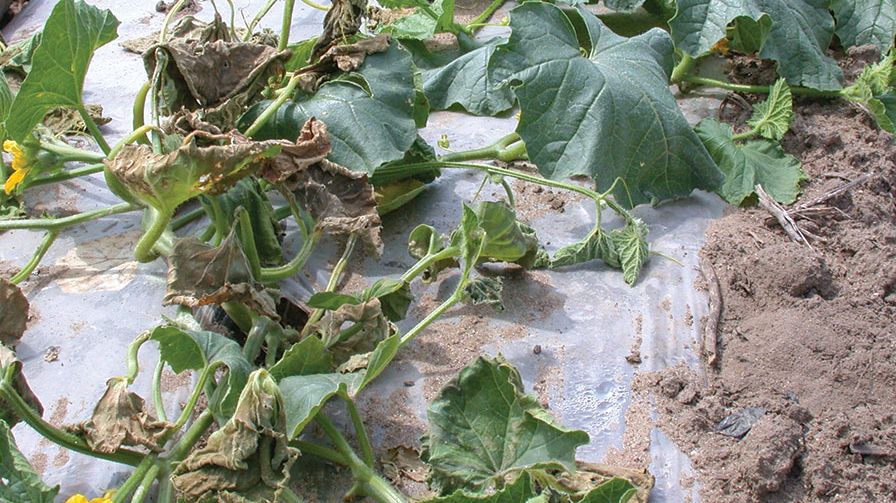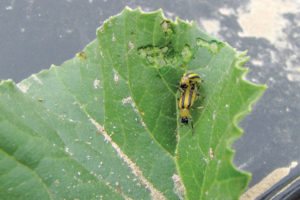Field Scouting Guide: Bacterial Wilt

Bacteria wilt. Photo by Dan Egel, Purdue University.
This month’s edition of American Vegetable Grower® magazine’s field scouting guide concentrates on Erwinia tracheiphila (bacterial wilt). Pathologists Daniel S. Egel, Purdue University, and Margaret Tuttle McGrath, Cornell University, share how to spot and treat this problem.
Basics
- Scientific name: Erwinia tracheiphila
- Common name: Bacterial wilt
- Geographical Range: Midwestern and eastern US, and southeastern Canada
- Crops affected: All cucurbit crops: cucumber, cantaloupe and, to some extent, pumpkins, squash and zucchinis.
Pest Impact
Egel: E. tracheiphila is vectored by the striped or spotted cucumber beetle. The beetle feeds and defecates on the plant. The bacteria that cause bacterial wilt are in the frass (beetle poop). One factor remains: moisture. It washes the frass into the wounds, allowing the bacteria to travel throughout the plant systemically.
Bacterial wilt causes death of the plant and, therefore, can affect yield. Cantaloupe and cucumber on affected vines may have poor quality fruit. There is usually a flush of striped cucumber beetles in May. These beetles can cause wilt on young plants. By mid-season, the vines have gotten large enough that bacterial wilt is less of a factor. Spotted cucumber beetles usually arrive later in the year and are not a big factor in bacterial wilt.
McGrath: Bacterial wilt is a problem throughout the Northeastern U.S., mostly with respect to cucumber. There is a variable occurrence (location and year-to-year) reflecting presence of bacterium and especially how well the vector (cucumber beetle) is managed. Substantial yield loss can occur, and it can occur at any stage. It is more damaging when it occurs early because the whole plant is affected rather than individual vines wilting.
Identification
Egel: Bacterial wilt results in wilting of the plant. Diseases or problems of the roots that cause wilting may be mistaken for bacterial wilt.
McGrath: Wilt also occurs with root and crown rot diseases; there are several pathogens affecting root and crown tissue of cucurbits. Sticky bacterial strands that appear when an affected stem is cut are a good diagnostic tool.
Recommended Treatment
Egel: Submit samples that you suspect may be bacterial wilt to a plant disease diagnostic laboratory. You may find the video “Field Test for Bacterial Wilt of Melons” useful. It shows a technique on how to give suspect wilted vines a field test for bacterial wilt.

Striped cucumber beetles can be a vector for bacteria wilt. If their frass contains the bacteria Erwinia tracheiphila, it can spread through out the vascular system. Photo by Dan Egel.
The threshold for applying a foliar insecticide is an average of one striped cucumber beetle per plant. Cantaloupe growers should use imidacloprid, or similar product, as a drench at transplant to manage the striped cucumber beetle.
Purdue University research indicates that the low rate of the imidacloprid will be sufficient to manage the cucumber beetles while doing minimum harm to bees. The treatment should protect vines for two to three weeks. At that time, you can apply insecticides labeled for striped cucumber beetles while paying close attention to label restrictions to protect bees (e.g., the label may indicate to apply product at night).
IPM/Organic Recommendations
Egel: Organic growers have had some success using row covers to exclude beetles. Note that growers should remove covers at flowering so that bees can pollinate.
I should note here that that bacterial wilt of tomatoes is a completely different disease.
McGrath: Growers can achieve control by managing the vector of this pathogen: spotted and striped cucumber beetles:
- Copper and other fungicides are not effective. Applying insecticide is the primary control method.
- Some growers have successfully used a perimeter trap.
- Growers have used row covers in small, typically organic, production fields.
- Organic growers can also use Pyganic (Pyrethrins).
There are beneficial nematodes, and researchers have observed some control of the vector can be obtained by growing a plant attractive to beneficial insects, like buckwheat, next to a cucurbit planting, However, it’s not documented through research, to my knowledge.
Traditional breeding has incorporated resistance to the bacterium into cucumber. But the resistance trait is linked to poor seed set, creating a major challenge. ‘Little Leaf’ pickling cucumber has resistance.










